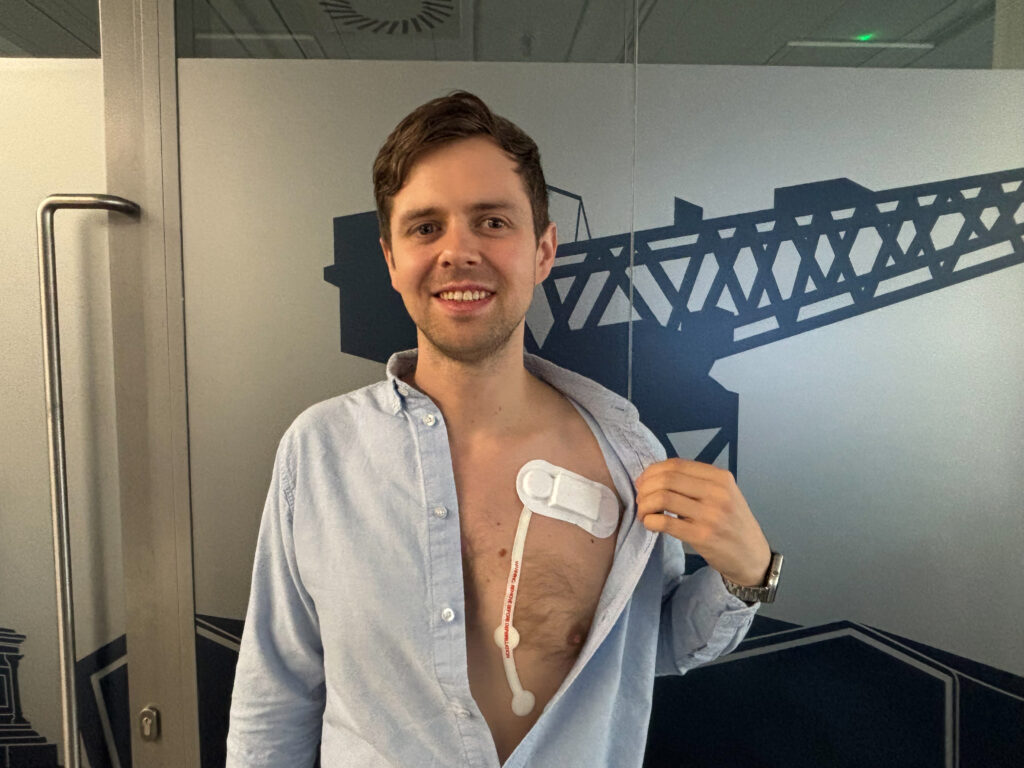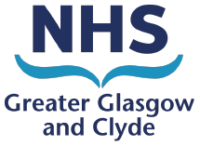
Health Secretary Neil Gray met clinicians and innovation leaders to see the impact of cutting-edge technology designed to prevent strokes and other health complications.
Mr Gray visited Glasgow’s Queen Elizabeth University Hospital to learn more about the Ambulatory Electrocardiogram (ECG) patch monitor technology used by NHS Greater Glasgow and Clyde, with support from the West of Scotland Innovation Hub, which is now being rolled out nationally.
The patches, which have been used in NHSGGC over the past two years, help speed up the diagnosis of atrial fibrillation (AF), a condition responsible for around one in four ischaemic strokes – often without symptoms.
They were developed to address long waiting lists for traditional cardiac Holter monitors and are far more user friendly as they can be worn like a plaster.
Unlike the older, bulkier monitors that are worn for just three days and require in-person fitting, the new ECG patches are lightweight, discreet, and can be posted directly to patients.
Worn continuously on the skin for up to 14 days – even during exercise and showering – the compact, wireless and water-resistant patches provide clinicians with more comprehensive data, improving detection and diagnostic accuracy of cardiac rhythm abnormalities such as AF, and speeding up the time to treatment.
This not only enhances patient experience but also has the potential to prevent significant numbers of strokes and AF-related complications.
The ECG patch monitors are expected to be four times more effective at identifying AF than current methods and will reduce diagnosis and treatment times from up to 24 months to just three weeks.
They have already been used by around 100 patients in Greater Glasgow and Clyde.
Mr Gray has announced £1.9 million to support national adoption through the Accelerated National Innovation Adoption (ANIA) pathway, ensuring around 8,000 patients across Scotland benefit from the pioneering technology annually.
The deployment of the ECG Patch Monitor could help:
- Reduce patient travel, as the patches can be applied at the point of diagnosis or posted to patients shortly after.
- Standardised access across Scotland will eliminate regional disparities in diagnosis and treatment times.
- Avoid an estimated 689 recurrent strokes over five years nationally, saving the NHS approximately £14.6 million.
- Over five years, release 15.7 full time cardiac physiologists to support the delivery of other critical cardiac diagnostic services.

The visit, which coincides with Scotland’s first Innovation Week, highlighted NHSGGC’s leadership and commitment to harnessing technology for better patient outcomes.
The national rollout, supported by the Scottish Government and delivered through the ANIA pathway, will ensure that more people across Scotland benefit from faster, more effective cardiac care.
Mr Gray was joined by NHSGGC Chief Executive Professor Jann Gardner, Medical Director Dr Scott Davidson, Research and Innovation Director Professor Jesse Dawson, Professor Dame Anna Dominiczak, Chief Scientist for the Scottish Government, Consultant Cardiologist Dr Faheem Ahmad, and Dr Katriona Brooksbank, Regional Head of Innovation for the West of Scotland Innovation Hub and NHSGGC.
The ANIA pathway, funded by the Chief Scientist Office and led by NHS Golden Jubilee’s national Centre for Sustainable Delivery, is designed to fast-track proven innovations into frontline healthcare on a “Once for Scotland” basis.
By identifying, assessing, and implementing new health technologies with strong evidence and impact, ANIA ensures that patients across Scotland benefit from the latest advances in care.
Health Secretary Neil Gray said: “This significant investment in innovative technology will make a real difference to the lives of thousands of stroke patients across Scotland.
“By accelerating diagnosis and treatment, we can help prevent recurrent strokes and enhance health outcomes.
“The use of these new patch monitors is a fantastic example of how we are adopting cutting-edge solutions to renew our NHS and ensure it can continue to deliver high-quality, efficient care for the people of Scotland.”
Professor Jann Gardner, Chief Executive of NHSGGC, said: “At NHS Greater Glasgow and Clyde, we are proud to be at the forefront of using technology to improve patient care.
“The ECG patch programme is a powerful example of how innovation can enhance diagnosis, reduce waiting times, and ultimately lead to better outcomes for patients.
“Our teams, in collaboration with the West of Scotland Innovation Hub, have shown what’s possible when we embrace new ways of working.
“We’re pleased that this work is now being adopted nationally, and we remain committed to leading the way in delivering smarter, more effective healthcare.”
NHSGGC Consultant Cardiologist, Cardiology Innovation Lead for the West of Scotland Innovation Hub and CfSD Clinical Lead for ANIA’s ECG patch programme, Dr Faheem Ahmad, has worked directly with patients using the ECG patch.
He said: “The introduction of the ECG patch has been a game-changer for both patients and clinicians.
“We’re now able to diagnose atrial fibrillation more quickly and accurately, which means we can start treatment sooner and reduce the risk of serious complications like stroke.
“The patches can be worn just like a plaster, and in comparison to the older, traditional Holter devices, they are more comfortable and easier for patients to use.
“Patients can also have the patches posted directly to their homes, helping us cut waiting times further.”
Katie Cuthbertson, National Director for the Centre for Sustainable Delivery, said: “Through the Accelerated National Innovation Adoption (ANIA) pathway, we are rapidly scaling technologies that have the power to transform lives.
“The rollout of ECG Patch Monitors is a prime example of how innovation can drive better outcomes across the NHS.
“By detecting atrial fibrillation earlier and more accurately, we are not only preventing recurrent strokes but also freeing up vital clinical capacity to support other cardiac services. This is innovation with impact, delivered at pace and scale.”

